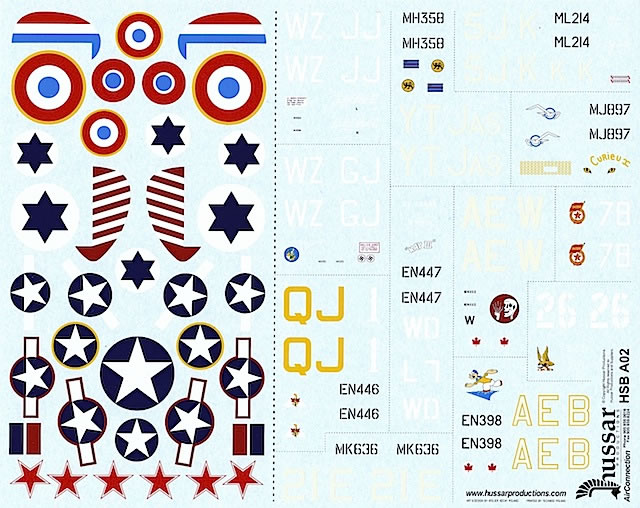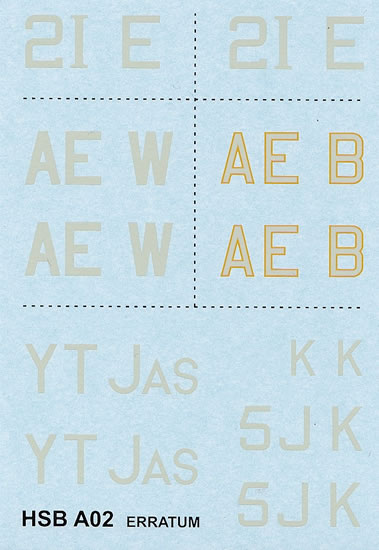Spitfire Mk.IX in Color
Detail and Color 2

Hussar Productions
1/48 scale
S u m m a r y : |
Catalogue Number: |
Hussar Productions Detail and Color 3
Spitfire Mk.IX in Color |
ISBN: |
978-0-9781091-4-1 |
Contents and Media: |
Soft cover, 24 pages, A4 format, full colour illustrations, English text; 2 x 1/48 waterslide decal sheets |
Price: |
Available online from AirConnection for Can$24.99. |
Scale: |
1/48 scale |
Review Type: |
First Look. |
Advantages: |
Well-researched and lavishly illustrated text; high-quality 1/48 decals. |
Disadvantages: |
A couple of very minor omissions from the decal sheet. |
Conclusions: |
I'm probably not alone in thinking the Spitfire is the most beautiful aircraft ever built, and that as a result you can never have too many decal options for the Spitfire kits in your stash! "Spitfire Mk.IX in Color" is a welcome release that features Spitfires operated by six different nations, including several notable and/or colourful machines. A number of the schemes here are in contention to feature on my next 1/48 Mk.IX build – the hard part will be deciding which one. Highly recommended. |
Reviewed by Brad Fallen

HyperScale is proudly sponsored by Squadron.com
The Supermarine Spitfire Mk.IX is a machine so thoroughly covered by kit and aftermarket decal manufacturers you'd think there would be no interesting aircraft left to present to modellers. Well Hussar Productions from Poland has teamed up with Brett Green and Jacek Jackiewicz to produce this gem of a publication, which illustrates and provides 1/48 decals for 12 Mk.IXs in a variety of tantalising schemes.
"Spitfire Mk.IX in Color" is more booklet than book. It's only 24 pages long and makes use of all available space: on the inside front cover is a description of the Mk.IX's key features (along with a select bibliography), and on the inside back cover are the final colour illustrations. And it’s all about the illustrations here, with two A4 pages devoted to each aircraft. On one page are port and starboard profiles and a short description of the aircraft and its history, and on the next are upper and lower surface views along with camouflage notes and/or colour swatches. Combined, this information builds up a picture of each Spitfire that will be more than enough for most modellers, while including enough pointers for those who want more detail to easily pursue it.
The featured aircraft are as follows; with the exception of options E, G, and I, all are camouflaged in Ocean Grey and Dark Green over Medium Sea Grey.
-
Spitfire Mk.IXc (late), MK 636/2I-E, flown by Squadron Leader Wally McLeod, 443 Squadron RCAF, 6 June 1944. Mk 636 wore full invasion stripes, along with Sky codes, spinner and fuselage band.
-
Spitfire Mk.IXc (early), BS 152/AE-W, flown by Squadron Leader Lorne M. Cameron, 402 Squadron RCAF, Kenley, early 1943. Probably the plainest Spitfire featured, BS 152 had Sky codes, spinner and fuselage band, red and white maple leaf emblems on both sides of the fuselage under the windscreen, and a black, red and white skeleton insignia on the lower port engine cowling.
-
Spitfire Mk.IXc (early), EN 398/AE-B, flown by Ian Keltie, 402 Squadron RCAF, March 1943. According to Alan Price in “Spitfire in Combat” this machine destroyed more enemy aircraft than any other Spitfire – 13 – all but one under the control of Wing Commander J.E. "Johnnie" Johnson. However EN 398 is depicted here before its use by Johnson, wearing yellow-bordered Sky codes, Sky spinner and fuselage band, red and white maple leaf emblems under the cockpit and a 'Popeye' insignia on the lower port engine cowling.
-
Spitfire Mk.IXc (late), MJ 897, operated by French tactical reconnaissance unit GR2/33 "Savoy", and shot down by flak on 4 January 1944. Within the limits imposed by its Ocean Grey/Dark Green/Medium Sea Grey camouflage MJ 897 was a very colourful aircraft, with its yellow empennage, wing bands and wingtips, red spinner and tricolour rudder and roundels.
-
Spitfire Mk.IXe, 2011/'White 26', operated by 101 Squadron, Israeli Air Force, md-1949. This ex-Czechoslovakian Spitfire was originally camouflaged in standard late war RAF Day Camouflage, but at some stage after commencing in Israeli service the Ocean Grey was overpainted in Brown. 'White 26' had a red spinner, red and white striped rudder and large white codes on the fuselage.
-
Spitfire Mk.IXc (late), ML 214/5J-K, flown by Wing Commander John Agorastos Plagis, 126 Squadron RAF, June 1944. Also wearing full invasion stripes, ML 214 had Sky codes, spinner and fuselage band, with the 'K' of the codes repeated in Sky on both sides of the rudder.
-
Spitfire Mk.IXc (early), EN 446/QI-1, operated by 92 Squadron RAF, Italy, 1943. Finished in Dark Earth and Middle Stone over Azure Blue, EN 446 had a black spinner and yellow and white fuselage codes.
-
Spitfire Mk.IXc (late), MH 358/YT-JAS, flown by Squadron Leader James Storrer, 65 Squadron RAF, Kingsnorth, autumn 1943. As Storrer's personal aircraft, MH 358 carried the codes YT-JAS in Sky both sides of the fuselage; it also had a Sky spinner and fuselage band.
-
Spitfire Mk.IXc (early), EN 447/WD-L, flown by Lt. Victor Cabas, 4th Fighter Squadron, 52nd Fighter Group, USAAF, Italy 1943. EN 447 carried hybrid national markings with USAAF stars in the port upper and starboard lower wing and fuselage sides, and an RAF fin flash and roundels on the starboard upper and port lower wings. Camouflage was Dark Earth and Middle Stone over Azure Blue.
-
Spitfire Mk.IXc (late), serial unknown/WZ-GJ, flown by Major Garth Jared, 309th FS, 31st FG, USAAF, Italy, January 1944. This USAAF Spitfire had a red spinner, white four-letter fuselage codes and national markings lacking an overall blue border.
-
Spitfire Mk.IXc (early), serial unknown/WZ-JJ, flown by 2Lt. John Fawcett, 309th FS, 31st FG, USAAF, Italy, March 1943. WZ-JJ was similar to option J, with the exception of red-bordered national insignia and thin red bands on the upper and lower wing surfaces outboard of the national markings.
-
Spitfire Mk.IXe, serial unknown/'White 78', Soviet 26th GvIAP, Leningrad, 1945. 'White 78' had white vertical tail surfaces and carried Soviet national markings in six positions. There were no national markings on the upper wings, but the different colours used to overpaint the RAF roundels there were clearly visible.
The accompanying decals have been printed on two sheets – one large sheet with all of the markings, and a smaller sheet marked 'erratum' with the Sky codes reprinted in a slightly darker colour.

The decals are by Techmod and well printed with no apparent quality control issues. Registration and colour appear to be perfect, and even the smallest insignia are crisply reproduced. The subtly different shades of red on the French roundels, Russian stars, Israeli tail stripes and US insignia borders are a welcome touch.

No RAF roundels are included, with Techmod presumably assuming that if you have a 1/48 Spitfire Mk.IX kit then you probably have these markings to hand.
There are a couple of limitations with the decals. According to the accompanying profiles (and backed up by period photos), the codes for marking option A had a thin dark border where they overlapped the invasion stripes – probably the underlying Dark Green or Ocean Grey. This border is not present on the decals, and will be difficult to accurately replicate with paint. There is a similar issue with the serial number for marking option D (the French aircraft) where the decal lacks the light background that is apparent on the profiles.
I'm probably not alone in thinking the Spitfire is the most beautiful aircraft ever built, and that as a result you can never have too many decal options for the Spitfire kits in your stash! In this context, "Spitfire Mk.IX in Color" is a welcome release with its combination of high-quality decals and well-researched and lavishly illustrated text. It features Spitfires operated by six different nations, and includes several notable and/or colourful machines. A number of the schemes here are in contention to feature on my next 1/48 Mk.IX build – the hard part will be deciding which one. Highly recommended.
Reference
Alfred Price, ‘Spitfire in Combat’ (Sutton Publishing, 2003)
Thanks to Air Connection for the sample
Hussar Products are
available
online from Air Connection
Text and Images Copyright © 2014 by Brad Fallen
Page Created 23 July, 2014
Last updated
23 July, 2014
Back to HyperScale Main Page
Back to Reviews Page |
Home
| What's New |
Features |
Gallery |
Reviews |
Reference |
Forum |
Search